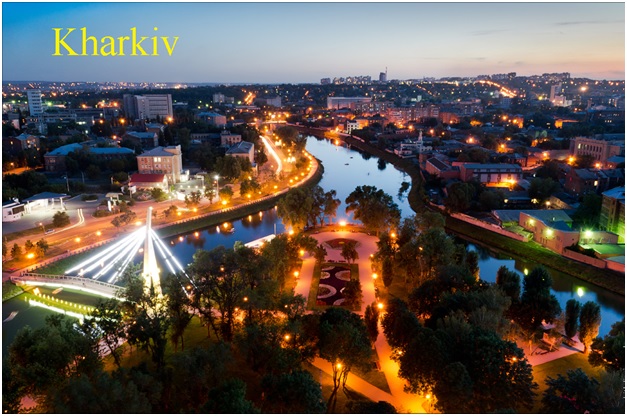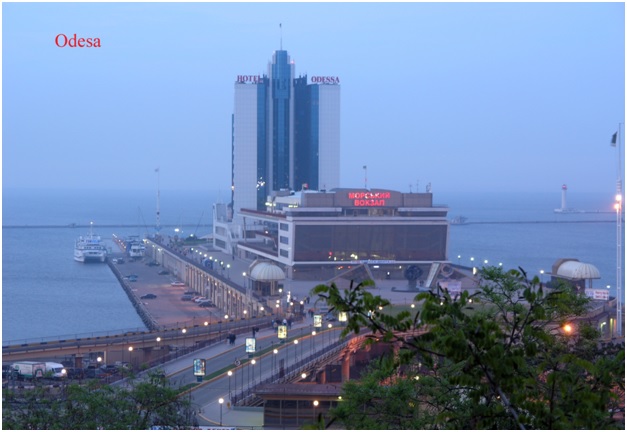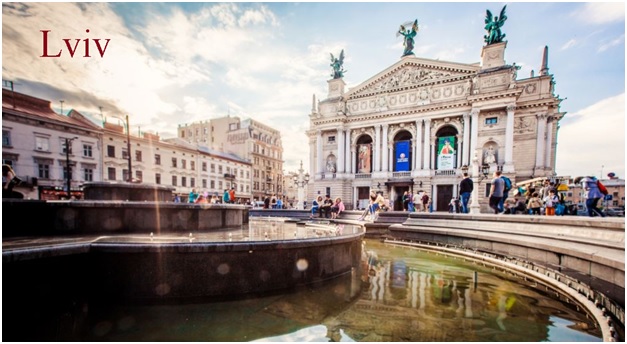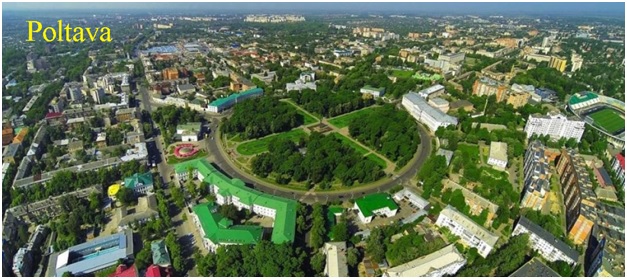Read and translate the text.
|
Big cities of Ukraine Ukraine is a country of ancient history, rich cultural traditions, developed industry and agriculture. Most Ukrainian big cities have a population of more than a million people and many industrial enterprises in and around them. They are usually surrounded by suburban areas from which many people commute to work at the cities’ factories and plants. All these cities have their peculiarities and their own historical and cultural places of interest.  Kharkiv A Look into the Past Kharkiv is the second largest city of Ukraine after Kyiv. According to some historic documents the city was founded as a Cossack Fortress at a strategically important place on the confluence of the rivers Kharkiv, Udy, Lopan and Nemyshlya in 1654. Though now archaeologists say that there was probably a more ancient Scynthian settlement on this place long before that time. The origin of the city’s name is still a mystery. There are at least two versions why the city was named so, but none of them is proved by documents. Some historians say that it came from the river whose name was already recorded on the Russian maps in 1627, others believe that it came from the name of a rich peasant Khariton, who was called Kharko by his neighbors. The first written document about the city dates back to 1653 and gives the name list of 20 families (587 adults) who settled on the bank of the River Kharkiv. having run from Poland, to escape the persecution of Polish landowners. A year later a big group of Cossacks headed by Voivode Seliphontov came to Kharkiv and began to built military fortifications on one of the hills over the river Kharkiv to defend border from the Crimean Tatars, The wooden fortress had ten towers and was surrounded by a double wall, a deep moat, swamps, forests and rivers. Many underground passages led to the rivers Kharkiv and Lopan, which allowed people to refill the water and food supplies in case of a siege. Later Voivode Seliphontov was appointed the first governor of Kharkiv by the Russian Tsar Alexey Michailovich, the father of Peter I. The strongly fortified settlement attracted people from nearby villages and they settled in and around Kharkiv, looking for protection and trade. In this way new suburbs, called sloboda appeared. Their names showed their location or trade, for example, Zalopanska clearly defined where it was situated, and Gonchrivka stated that its dwellers made and sold pottery. The first streets in Kharkiv started to appear in the second half of the 17th century. Part of them were roads that led to other cities like Sumska, Belgorodska Zmiyivska and later Ekaterinoslavska (now Poltavsky Shlyakh). Others informed the citizens where they had to go to buy something or to get something done, because workmen of one trade preferred to live together: Kotsarska - carpet makers, Chebotarska — shoe-makers, Rymarska — leather makers, Kuznetska — blacksmiths and so on. Industrial Boom 1869 was another important year in Kharkiv’s history — the first railway line was built in Kharkiv which gave a new impulse to the development of trade and industries in the city. In the years that followed several new plants, factories and the first electric power station were opened. The city started to turn into an industrial centre. The First Capital The beginning of the 20th century was probably the most difficult and unstable period in the history of Ukraine in general and Kharkiv in particular. The Russian revolutions and the Civil war were real dramatic events which separated people into Reds and Whites and brought much grief to both sides. In 1919 Soviet power was established in Ukraine, and Kharkiv became its first capital. Until 1934 the city was the main political, administrative, scientific and cultural centre of Ukraine. A lot of new plants were built there (for example, the Kharkiv Tractor Building Plant), and new educational establishments, libraries and museums were opened. One of Kharkiv’s landmarks —Gosprom (the House of State Industry) was designed as the first high-rise building in the country and finished in 1928. Another impressive building on the present Independence Square that was erected at that time is Kharkiv National University. The pre-war period in Kharkiv was not only a constructive but also a destructive one as many beautiful churches were pulled down in the anti-religious campaign. The older citizens of Kharkiv regretfully recollect the beautiful Nikolsky Cathedral that used to stand at the place where «Dzerkalna truya» («The Mirror Flow»), one of the symbols of Kharkiv, is situated now and the fine St. Michael’s Church that stood in the modern Uritsky Square. 1941 — 1950s During the Great Patriotic War, Kharkiv and its citizens suffered greatly. Practically all the industrial enterprises were evacuated to Siberia, and there was no work and no food in Kharkiv and region. Most of the houses were destroyed, many people were taken to slavery in Germany, or killed by the fascists in Sarzhin Yar and other places in and around Kharkiv. After the members of Kharkiv Underground organization blew up the German Headquarters on November 14, 1941, 250 peaceful citizens were shot and several others were hung on the balconies of the hotel in Dzerzhinsky Square and on the lamp posts along Sumska Street. In 1942 and 1943 there were fierce battles around Kharkiv and practically every inch of our soil was soaked with blood. If you walk in the woods and forests around Kharkiv, you will still see a lot of trenches left since that time and there is always a danger of finding old ammunition. Kharkiv was finally liberated on 23 August 1943, and this day is one of the most important holidays for the people of the city. The post-war period was extremely difficult for Kharkiv as its people had to reconstruct not only the houses but also the huge industrial sector completely destroyed by the war. It was only in 1950 that the reconstruction was finished and all Kharkiv plants started to work. The Present Day of Kharkiv Nowadays Kharkiv is proud of its newly reconstructed streets and buildings, its well-planned underground (first line opened in 1975), its 26 educational establishments and 6 theatres, 4 big museums and numerous art galleries, its libraries (the biggest of which are the Korolenko and the National University Libraries), its brightly-lit shops and huge markets. Despite the economic crisis that Independent Ukraine is undergoing now, most of Kharkiv’s plants and factories continue to work producing planes, tractors, turbines, electrical generators, different machines and tools, medicines, textile, medical, military and space equipment, food products and many other consumer goods. 1,716 Kharkiv enterprises trade with 105 countries of the world. Kharkiv is an important administrative centre that coordinates the activity of several region centres. Kharkiv has its own city emblem — the Horn of Plenty with fruit and flowers in it and the Mercury Wand entwined (girded) by silvery snakes. Kharkiv has several sister-cities: Cincinnati in the USA. Nurnburg in Germany, Lil in France. Sister-cities exchange delegations and mutually enrich each other in cultural, intellectual and other respects. Kharkiv is also a significant transport centre with several railway and bus stations and an international airport. Kharkiv has always been a city of students. The main higher educational establishments are Kharkiv National University named after V.N. Karazin, Kharkiv Polytechnic University, Kharkiv University of Radio-Electronics named after Yangel, Kharkiv Aviation Institute and many others. |

|
Read and translate the text.
 Odesa, the southern seapearl of Ukraine There is hardly a person in Ukraine who has never heard about Odesa with its golden sandy beaches, noisy Derebasrvska, high Potomkrnska Lestnitsa (stairs), its beautiful Opera and Ballet theatre, and its colorful and plentiful Privoz market. Odesa is a comparatively young city. It was founded in the 14th century on the Black Sea shore, in one of its shallow natural harbors. It started as a small fishing settlement, and was first mentioned as the Tatar settlement of Khadzhybey in I415. Later it passed to Rich Pospolita, and in I764 to Turkey. During the Russian-Turkish war of l787-l79l, the Ukrainian Black Sea Cossacks conquered the Turkrsh fortress that was built near Khadzhybey. Four years later the settlement was seized by the Russian army, and already referred to as a town. In I795 it was renamed Odesa. The name is said to derive from the French word «eau» meaning «water» and honoring the mineral and healing waters of the city’s natural springs. There is another version, saying that it was named after an ancient Greek colony which existed not far from the present Odesa. The history of Odesa is the history of a cosmopolitan city with a mixture of people of different nations who lived there or came there on their ships. You can find there the influence of Greek, Italian, Turkish, French, Ukrainian, Moldovan, Jewish and many other cultures. The citizens of Odesa even consider a Frenchmen, Duke de Richelieu (who later was the Prime Minister of France) to be the founder of their city, though he was just one of the city mayors. The history of Odesa is Connected not only with holiday-making and trade. There were years when the citizens of Odesa suffered greatly: during the heroic defence of the city in the Crimean war of 1853 – 1856, in the years of the Civil War, and especially during the Great Patriotic War. Being the biggest seaport in Ukraine, Odesa is called «a Southern window to Europe», and it is a leading centre of sea trade with all the countries of the world. For the citizens of Odesa the port is the heart of the city because it is here that the commercial fleet of Ukraine is berthed, and it is the port that gives jobs and money to the city. An endless stream of cruise liners, freight and cargo ships, tankers and boats under the flags of different countries of the world fill Odesa's harbor every day. It is not be accurate to say that Odesa has no industry. Its plants and factories produce machine tools and cranes, fertilizers and other chemical products, as well as medicine and food. There is an oil – refinery plant and a jute mill and a number of consumer goods enterprises. People who come to Odesa to have a rest know it as a balneological spa with hundreds of holiday centers. Those who need eye treatment turn to the famous Filatov Institute of Eye Diseases. Theatre and museum goers can enjoy Odesa's nine theatres and numerous museums and picture galleries. Odesa Opera and Ballet Theatre remembers the singing of Fedir Shalyapin, Leonid Sobolev and Alexandra Nezhhdanova, the dancing of Anna Pavlova and Galina Ulanova, concerts conducted by Petr Tchaikovsky and Nikolay Rimsky-Korsakov. People who love architecture can enjoy wandering about Odcsa'a streets and admiring the amazing old buildings. Nowadays Odesa has become «the capital of humor». It has always been famous for the peculiar humor of its citizens, and now it is the place of annual Humor Festivals that take place on April 1. To cut the long story short, Odesa is a place to which you always want to return. |

|
Read and translate the text.
 Lviv This old Ukrainian city is more than 700 years old. In the middle of the 13th century it was founded as a fort by Prince Danylo Halytsky, on the place of an earlier settlement that dated back to the 6th century. Danylo named the city after his son Liv. As a town Lviv was first mentioned in the early chronicals in I256. Because the city was located on the crossroads of trade routes from the Black to the Baltic seas, it grew very quickly as a major market centre which connected Moscow with Western Ukraine and Europe. Halychina, with Lviv as its capital city, was taken over by Poland in the 14th century and the Ukrainian nobility of the time eventually adopted Polish as the official language, and Roman Catholicism as the official religion. But common people continued to speak Ukrainian and remained Orthodox, though later some of them joined the Greek Catholic Church. In the l6th and l7th centuries Lviv was an important trade, industrial and cultural centre. It was there that Ivan Fyodorov printed his first «Apostle» and «Azbuka» more than 400 years ago. It so happened that Lviv has had to change its nationality many times, for example, in I772 Halychina became part of the Habsburg Austro-Hungarian Empire; then at the end of the First World War it was proclaimed the capital of the Independent Republic of West Ukraine, but very soon it returned to Poland again, until l939 when it was included into the USSR. All these changes couldn't but influence the national characteristics and the language of Lviv citizens. There are many Polish and Hungarian words in their local dialect which makes it extremely unique and interesting. Now Lviv is a large city, a major economic, educational and cultural centre of the Western region of Ukraine. It is proud of its University which is the oldest in our country and was opened in 1784. Lviv is a large industrial centre which produces buses, TV sets, food products and various consumer goods. Lviv is a fantastically beautiful place in which architectural masterpieces of different historic periods are united in a harmonious integrity. There are special attractions in Lviv that are known only to the native citizens or specialists. One of them is that there are 350 kilometers of streets cobbled with stones and all of them have different patterns and colors. Another example is certain type of a kerosene lamp which was invented in this city and is now exhibited in one of its numerous museums. One of the most mysterious and romantic places of interest in Lviv is High Castle, where you can find the ruins of a fortress erected by King Kazimir III at the end of the XIV century. Some people believe that there are even ghosts in the ruins - old custodians of the Castle who can be seen on moonless nights. Not far from High Castle is Shevchenko Grove with a collection of samples of ancient Ukrainian wooden architecture. It is difficult to enumerate all the sights of Lviv. They are more than one thousand, and you'll need more than a week to see all of them. But the most interesting that are worth seeing are: The Arsenal and the Powder Tower built in the 16th- I 7th centuries; the impressive Dominican Church and the Boim's Chapel, the Armenian and Assumption Cathedrals; St. Yura‘s Cathedral, and the famous Lviv Opera and Ballet Theatre. If you want to see the beauty of Lviv, it is better to wander around it, to climb the narrow cobbled streets and to breathe the air of the city which was described by the Lviv poet Bartholomew Zimorovich like this, «This city was born under the sky and the stars which involuntarily inspire longing for beauty. |
Read and translate the text.
 Poltava In 1999 Poltava celebrated its 1100th birthday, but the actual date of its founding is not clear. Archaeologists found the remains of ancient dwellings from the Paleolithic era in one of the city districts Bila Hora, and from the Scynthian and Slavic cultures under Soborny Maidan. So Poltava is one ofthe oldest cities in Ukraine. It is situated on the right bank of the Vorskla River (which according to one ofthe legends got its name from Empress Catherine ll after «stealing» her glasses), the left tributary of the Dnipro. It is not a very large city. lts population is about 350,000, but you can hardly find a more attractive and charming place in Ukraine. especially in late spring and early autumn. Poltava’s first name was Ltava. and as such the settlement was first described in the Hypatian Chronicle. lts present name was first mentioned in the 15th century. For two centuries Poltava belonged to Pereyaslav Principality, but in 1646 it was captured by the worst enemy of Ukrainian Cossacks -Yarema Vyshnevetsky. During the Liberation War of 1648 the city was the base of the Poltava regiment. Poltava region with its rich black soils was always a temptation for foreign invaders. The Tatars raided the city several times. and their last invasion took place in 1695. Then in 1709 there was a three-months seige of the city by the Swedish army, lead by King Charles ll, together with the army of the Ukrainian Hetman lvan Mazepa, which was followed by a battle of these armies against the Russian troops, headed by Peter I. The details ofall these and many other historic events can be found in Poltava museums. Today Poltava is a busy regional centre with developed industrial and agricultural spheres, with dozens of higher educational establishments and hundreds of schools and libraries [t has a large cotton mill and food-processing enterprises. The people who live there are friendly and hospitable, and their melodius Ukrainian language sounds like a song. When you enter or leave Poltava, you see a big road sign «Welcome to Poltava» and you really know that you are a welcomed guest there. |
| Key AL |